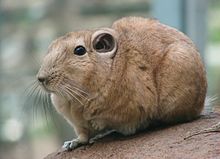| Gundi Temporal range:
| |
|---|---|

| |
| Ctenodactylus gundi | |
| Scientific classification | |
| Domain: | Eukaryota |
| Kingdom: | Animalia |
| Phylum: | Chordata |
| Class: | Mammalia |
| Order: | Rodentia |
| Infraorder: | Ctenodactylomorphi |
| Family: | Ctenodactylidae Gervais, 1853 |
| Type genus | |
| Ctenodactylus Gray, 1830
| |
| Genera | |

| |
Gundis or comb rats (family Ctenodactylidae) are a group of small, stocky rodents found in Africa. They live in rocky deserts across the northern parts of the continent. The family comprises four living genera and five species (Speke's gundi, Felou gundi, Val's or desert gundi, common or North African gundi and Mzab gundi), as well as numerous extinct genera and species.[1] They are in the superfamily Ctenodactyloidea. Local people in northern Africa have always known about gundis, however they first came to the notice of western naturalists in Tripoli in 1774, and were given the name gundi mice.[2] While they are not regarded as pests, some people hunt gundis for food.[3]
All living gundi species are members of the Ctenodactylinae sub-family. The Ctenodactylidae family also includes three extinct sub-families, Tataromyinae, Karakoromyinae and Dystylomyinae.[4]
- ^ McKenna, Malcolm C.; Bell, Susan K. (1997). Classification of Mammals above the Species Level. New York: Columbia University Press. ISBN 0-231-11013-8.
- ^ Macdonald, David W., ed. (2006). The Encyclopedia of Mammals. Oxford University Press. ISBN 0-19-920608-2.
- ^ Cite error: The named reference
Grzimekwas invoked but never defined (see the help page). - ^ López-Antoñanzas, Raquel; Knoll, Fabien (2011). "A comprehensive phylogeny of the gundis (Ctenodactylinae, Ctenodactylidae, Rodentia)". Journal of Systematic Palaeontology. 9 (3): 3. doi:10.1080/14772019.2010.529175.